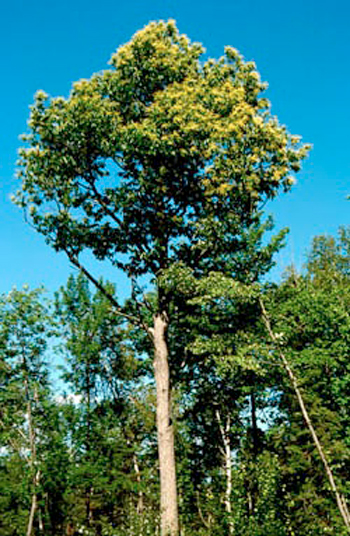A Note on the Once Great
American Chestnut Tree

Before 1910, 30% of Pennsylvania forests and much of New England’s forests were chestnut. Now they are nearly extinct in diameters over 3 inches. Above is the tallest American Chestnut in the U.S., located north of Fryeburg in Lovell, Maine. Jared Westbrook photo
The American chestnut (Castanea dentata) is a large, deciduous tree of the beech family native to eastern North America. Before the species was devastated by the chestnut blight, a fungal disease, it was one of the most important forest trees throughout its range, and was considered the finest chestnut tree in the world. It is estimated that between 3 and 4 billion American chestnut trees were destroyed in the first half of the 20th century by blight after its initial discovery in 1904. Very few mature specimens of the tree exist within its historical range, although many small shoots of the former live trees remain. There are hundreds of large (2 to 5 ft diameter) American chestnuts outside its historical range, some in areas where less virulent strains of the pathogen are more common, such as the 600 to 800 large trees in northern Lower Michigan.
The nuts were once an important economic resource in North America, being sold on the streets of towns and cities, as they sometimes still are during the Christmas season (usually said to be “roasting on an open fire” because their smell is readily identifiable many blocks away). Chestnuts are edible raw or roasted, though typically preferred roasted. Nuts of the European sweet chestnut are now sold instead in many stores. The unrelated horse-chestnut’s seeds are poisonous without extensive preparation. Native Americans used various parts of the American chestnut to treat ailments such as whooping cough, heart conditions and chafed skin.

American Chestnut, Atkinson, Maine. Dense, ivory-colored spring chestnut blooms once covered the crown of large swaths of New England’s forests.
The January 1888 issue of Orchard and Garden mentions the American chestnut as being “superior in quality to any found in Europe.” The wood is straight-grained, strong, and easy to saw and split, and it lacks the radial end grain found on most other hardwoods. The tree was particularly valuable commercially since it grew at a faster rate than oaks. Being rich in tannins, the wood was highly resistant to decay and therefore used for a variety of purposes, including furniture, split-rail fences, shingles, home construction, flooring, piers, plywood, paper pulp, and telephone poles. Tannins were also extracted from the bark for tanning leather.
The American Chestnut was a rapidly growing deciduous hardwood tree, historically reaching up to 98 ft. in height, and 9.8 ft. in diameter. It ranged from Maine and southern Ontario to Mississippi, and from the Atlantic coast to the Appalachian Mountains and the Ohio Valley. C. dentata was once one of the most common trees in the Northeastern United States. In Pennsylvania alone, it is estimated to have comprised 25–30% of all hardwoods. The tree’s huge population was due to a combination of rapid growth and a large annual seed crop in comparison to oaks which do not reliably produce sizable numbers of acorns every year. Nut production begins when C. dentata is 7–8 years old.
American Sycamore–Another example of potential growth of some species
An American sycamore tree can often be easily distinguished from other trees by its mottled exfoliating bark which flakes off in great irregular masses, leaving the surface mottled, and greenish-white, gray and brown. The bark of all trees has to yield to a growing trunk by stretching, splitting, or infilling; the sycamore shows the process more openly than many other trees. The explanation is found in the rigid texture of the bark tissue which lacks the elasticity of the bark of some other trees, so it is incapable of stretching to accommodate the growth of the wood underneath, so the tree sloughs it off.
A sycamore can grow to massive proportions, typically reaching up to 98 to 131 ft. high and 4.9 to 6.6 ft. in diameter when grown in deep soils. The largest of the species have been measured to 167 ft., and nearly 13 ft. in diameter. Larger specimens were recorded in historical times. In 1744, a Shenandoah Valley settler named Joseph Hampton and two sons lived for most of the year in a hollow sycamore in what is now Clarke County, Virginia. In 1770, at Point Pleasant, Virginia (now in West Virginia) near the junction of the Kanawha and Ohio Rivers, George Washington recorded in his journal a sycamore measuring 44 ft 10 in in circumference at 3 ft. from the ground.
Yale Study
“Trees are among the most prominent and critical organisms on Earth, yet we are only recently beginning to comprehend their global extent and distribution. They store huge amounts of carbon, are essential for the cycling of nutrients, for water and air quality, and for countless human services. Yet you ask people to estimate, within an order of magnitude, how many trees there are and they don’t know where to begin. I don’t know what I would have guessed, but I was certainly surprised to find that we were talking about trillions.” - Thomas Crowther, Yale Climate & Energy Institute post-doctoral fellow, Yale School of Forestry & Environmental Studies (F&ES) and lead author of the study.
